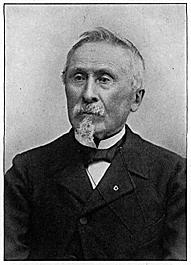
Pierre Louis Victor Lemoine (October 21, 1823 in Delme, Moselle - December 11, 1911) was a celebrated and prolific French flower breeder who, among other accomplishments, created many of today's lilac varieties. As a result of his accomplishments, the term French lilac has come to mean all cultivars of the common lilac that have double flowers,[1] regardless of their origin.
Career
editIn 1849, Lemoine established his independence by buying property 40 miles away from his family and an opening his own nursery at Nancy, France. By 1850 Lemoine had established himself as a florist and gardener, and by 1852 the Revue Horticole mentioned Lemoine's double flowered Portulaca. In 1854 Lemoine produced the first double Potentilla (Gloire de Nancy), and the first Streptocarpus hybrids. It was about the same period that Lemoine turned his hand to fuchsias and introduced many varieties, including the double flowered hybrid Solferino. By 1862 he had introduced a white Spiraea callosa, in 1866 the first genuine double-flowered zonal Pelargonium geraniums (Gloire de Nancy), and in 1868 the first of his hybrid weigelas.
The greatest of his creations, though, were undoubtedly his lilacs. Starting in 1870 Lemoine and his descendants (Émile Lemoine (1862-1942) and Henri Lemoine (1897-1982)) introduced over 200 new lilac cultivars. In 1876 he created the double French hybrids and hybridized the first hyacinthiflora lilacs, the result of crosses between the early-blooming Syringa oblata and the familiar S. vulgaris. In all, Lemoine created 214 lilac cultivars during his lifetime, most of these were commercial successes. However, his work was by no means confined to lilacs. During the last fifteen years of his life he produced excellent new varieties of Astilbe, cannas, Delphinium, Deutzia, Gladiolus, Heuchera, Hydrangea, Penstemon, peonies, Philadelphus, and Weigela, as well as more modest efforts in chrysanthemums, dahlias, bush honeysuckles, Montbretia, Phlox, saxifrages, and Spiraea.
References
edit- ^ Lilacs the Genus Syringa by Father John Fiala